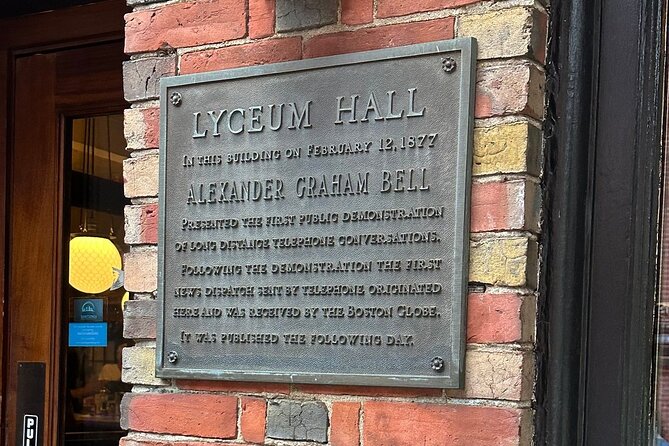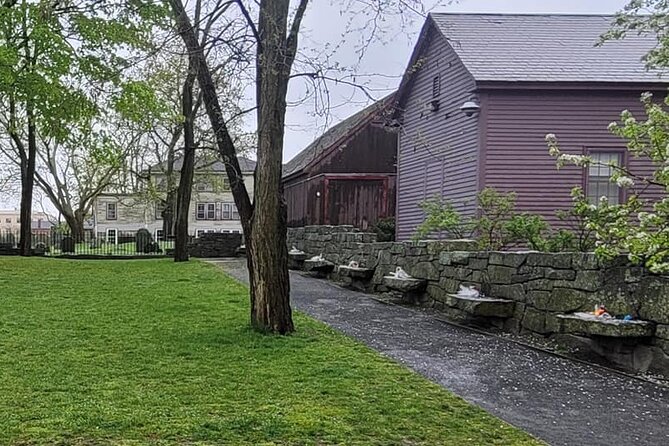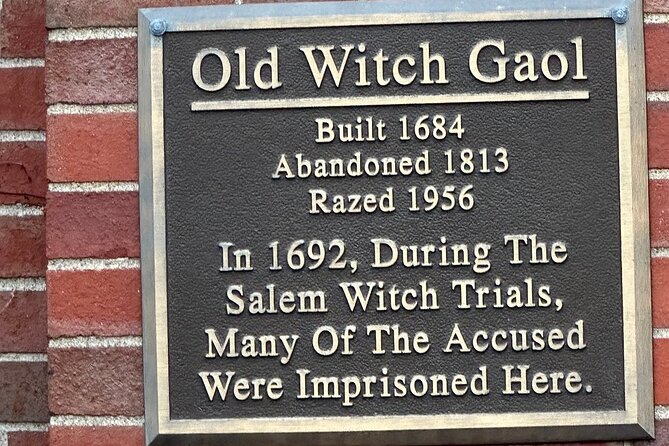The "Historians Guide to the Salem Witch Trials" offers a comprehensive look at one of the most notorious chapters in American history. It doesn’t simply recount the events – it delves into the complex societal, political, and gender dynamics that fueled the mass hysteria. By exploring the personal stories of the victims and the motivations behind the accusations, the guide provides critical insights that challenge common misconceptions. Readers will come away with a deeper understanding of this dark period and the vital lessons it holds for today.
Good To Know

-
The Salem Witch Trials were a series of prosecutions for witchcraft in colonial Massachusetts, resulting in the execution of 19 people between 1692-1693.
-
Accusations were often based on vague signs and underlying factors like property disputes, reflecting societal fears of female autonomy.
-
Victims faced horrifying interrogation methods, imprisonment without trial, and death from disease and neglect, exposing greed, vengeance, and power struggles.
-
The disproportionate impact on women highlights the gendered nature of the trials and the injustices inflicted upon marginalized members of society.
-
The trials serve as a symbol of mass hysteria, intolerance, and the dangers of unchecked authority, providing crucial lessons for historians and the general public.
Overview of the Salem Witch Trials
The Salem witch trials were a series of prosecutions for witchcraft that occurred in colonial Massachusetts between 1692 and 1693.
Fueled by religious fervor and societal tensions, over 200 people were accused of practicing witchcraft, with 19 ultimately executed.
The trials began in the town of Salem and spread throughout the region, with accusations and executions taking place in various towns.
The trials ended after the governor of Massachusetts intervened, pardoning and releasing the remaining accused.
This dark chapter in American history has become a symbol of mass hysteria, intolerance, and the dangers of unchecked authority.
You can also read our reviews of more guided tours in Salem
The Reality of Witchcraft Accusations

While the Salem witch trials captivated the public’s imagination, the reality of the witchcraft accusations was far more complex. Accusers often cited vague signs like strange birthmarks or peculiar behavior as evidence of a pact with the devil.
Underlying factors like property disputes, religious fervor, and personal vendettas fueled many of the accusations. The majority of those tried and executed were women, reflecting the patriarchal society’s fear of female autonomy.
Ultimately, the trials reveal the danger of mob mentality and the importance of critical thinking when confronted with extraordinary claims lacking substantial proof.
The Stories of the Victims

Behind the numbers and statistics lie the personal stories of the victims of the Salem witch trials.
These individuals, from all walks of life, were accused, imprisoned, and in many cases, executed for witchcraft – a crime they didn’t commit. Their names have become etched in history: Rebecca Nurse, Bridget Bishop, and Giles Corey, among others.
Through the accounts of their trials and final moments, we gain a deeper understanding of the human toll of this dark chapter. Their stories serve as a sobering reminder of the devastating consequences of mass hysteria and religious fervor run amok.
Curses and Crimes During the Trials

Although much of the focus during the Salem witch trials was on the alleged supernatural powers and rituals of the accused, the real horrors centered on the very human crimes committed in the name of rooting out witchcraft.
Victims were subjected to horrifying interrogation methods, including torture, in an effort to extract confessions. Many were imprisoned for months without trial, denied food and water, and eventually hanged.
Others died in custody from disease and neglect. The trials were rife with greed, vengeance, and power struggles, revealing the darker side of human nature rather than any true supernatural forces at work.
The Feminist Perspective on the Trials

The feminist perspective on the Salem witch trials emphasizes the disproportionate impact on women, who made up the vast majority of the accused.
These trials reflect the social and political environment that allowed for the persecution of women, often widows or outcasts, who challenged the patriarchal norms of the time.
The guide’s focus on sharing the victims’ stories from a feminist lens provides a critical understanding of the gendered nature of the trials and the lasting legacy of the injustice inflicted upon these women.
This unique approach sets the tour apart, offering visitors a deeper, more nuanced exploration of this dark chapter in history.

As visitors embark on the Salem Witch Trials tour, they’ll be captivated by the guide’s ability to bring the historical sites to life.
The tour starts at Captain William Driver Park, where the guide sets the stage for the harrowing events. From there, the group ventures to the Old Witch Gaol, a haunting reminder of the harsh realities faced by the accused.
The tour culminates at the Salem Witch Trials Memorial, a solemn space to reflect on the victims’ stories.
Throughout, the guide’s expertise and sensitivity ensure an immersive, thought-provoking experience that illuminates this dark chapter of American history.
The Tour Guide’s Approach to Storytelling

The tour guide’s approach to storytelling is captivating and deeply engaging.
As a specialized historian in witchcraft, they bring the dark history of the Salem witch trials to life with a masterful blend of facts and emotional resonance.
Their narrative style is both informative and immersive, transporting visitors back in time while highlighting the tragic realities faced by the victims.
With a feminist perspective, the guide shines a light on the gendered nature of the trials and the injustices experienced by the accused.
Audiences leave the tour with a profound understanding of this complex and often misunderstood chapter in American history.
Traveler Perspectives and Recommendations

What do travelers have to say about this Salem witch trials tour? According to reviews, it’s a hit with 98% of visitors recommending it.
Travelers praise the guide’s extensive knowledge and captivating storytelling, which bring the dark history to life without embellishments. Many highlight how the tour’s feminist perspective and focus on victim’s stories make it a truly informative experience.
Overall, reviewers describe the tour as "informative and entertaining," with one saying it’s "the best way to learn about the witch trials."
The Salem Witch Trials Guide offers a must-do experience for anyone interested in this chilling chapter of history.
Frequently Asked Questions
Are the Salem Witch Trials Still Relevant Today?
The Salem witch trials remain relevant today, as they highlight the dangers of fear-driven persecution and the need to protect individual rights. Their lessons continue to resonate in modern society’s ongoing struggles against intolerance and injustice.
What Were the Social and Political Factors Behind the Trials?
The Salem witch trials were fueled by social tensions, religious zealotry, and political power struggles in Puritan New England. Accusations targeted women, revealing underlying gender dynamics and fears within the rigid Puritan social order.
Did Any Witches Actually Exist in Salem During That Time?
There’s no evidence that actual witches existed in Salem during the witch trials. The accusations were fueled by social and political tensions, religious beliefs, and mass hysteria – not by the presence of real witchcraft.
How Have the Events in Salem Impacted Modern Witchcraft Practices?
The Salem witch trials have significantly influenced modern witchcraft practices, inspiring increased openness, a rejection of negative stereotypes, and a focus on empowering marginalized groups through reclaiming the label "witch."
What Are Some Lesser-Known Facts About the Trials That Are Often Overlooked?
Many don’t know the trials disproportionately targeted women who challenged social norms, like midwives and herbalists. The court’s use of spectral evidence also allowed baseless accusations to thrive in the absence of physical proof.
The Sum Up
The "Historians Guide to the Salem Witch Trials" offers a comprehensive understanding of this tragic chapter in American history. It delves into the complex societal, political, and gender dynamics that fueled the mass hysteria, highlighting the personal stories of the victims and the lessons learned about justice and human rights. This essential resource sheds light on a dark period, guiding readers to navigate the historical sites and appreciate the nuances of this profound narrative.
More Guided Tours in Salem
- Multilingual Self-Guided Audio Ghost Tour in Salem
- Salem Voodoo, Vampires, and Ghosts Guided Walking Tour
- Salem Merchants and Mansions Guided Architecture Walking Tour
- Tales of Salem Halloween Guided Walking Tour
- 2.5-Hour Salem History & Sightseeing Guided Walking Tour
- Salem Witch Trials Self Guided Tour With Interactive Trivia Quiz
More Tour Reviews in Salem
Not for you? Here's more nearby things to do in Salem we have reviewed
- Salem Walking Activity Tour with Maritime Historic Site visit
- Best Hocus Pocus Movies & More Tour
- Ghostly Tales of Salem Walking Tour
- High Witch History Walking Tour of Salem
- Spooky Ramen Comedy Walking Tour
- Salem Movie Magic Tour: Hocus Pocus and Bewitched locations
- Ghost Tour with free Ghost Hunting Gear in Old Salem
- Salem: Spanish-Speaking Witch Trials Walking Tour
- Hocus Pocus Film and Tour. See the Movie Walk the Magic
- Creepy Salem Ghost Tour with Free Ghost Hunting Gear
- Multilingual Self-Guided Audio Ghost Tour in Salem
- Salem: Boos and Brews Haunted Pub Crawl
